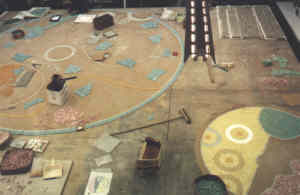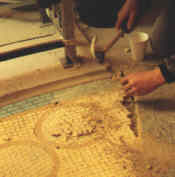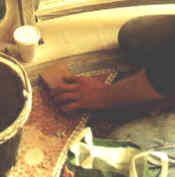
 |

Mosaic Matters - Art Pavements and Decorations LtdThis is an article that appeared in the Summer 92 edition of Mosaic Matters. Unfortunately Art Pavements are no longer trading, but Chris Smith is still working on other projects involving mosaics. Anyone travelling to the British Museum via Tottenham Court Road tube station has the chance to see two aspects of Art Pavements' work, which ranges from conserving and restoring ancient mosaics to creating modern ones. The firm has not only rebacked and conserved most of the British Museum collection, but has been largely responsible for the conservation of Roman mosaics in Britain, such as those at Bignor Villa and Fishbourne Palace. It was Art Pavements that carried out the superb restoration of the forth century Orpheus pavement at Littlecote, Wiltshire, a task which involved half a million or so glaze-stained ceramic tesserae. The firm is equally happy to collaborate in making new mosaics, such as those at Tottenham Court Road Station. Paolozzi's flamboyant designs for the Rotunda, The Oxford Street entrance, and above the escalators, were realised as mosaic, using a mixture of vitreous, smalti and piastrelle, a variety of smalti. Other recent work includes Tim Clapcott's marble, smalto and porcelain Phoenix Pavement at the Royal College of Art, Jane Muir's medieval-style Beckets Well panels, and Sue Ridge's spectacular 240 x 10 foot mural at Southampton Station.
When I visited the factory at Kimbolton, Cambridgeshire, earlier this year, they were principally engaged in making contemporary mosaics, this time from designs by Jennifer Durrant. These were intended for the Thomas Neal development, a new shopping mall at Seven Dials in Covent Garden, between Earlham Street and Shorts Gardens. Floor mosaics of this kind, and on this scale, are done by the usual reverse method, glued onto paper, cut into sections, and on site are set into an inch or so of sand and cement. The last part is the trickiest, of course, particularly if the setting areas at the site do not have precisely the dimensions that the designer asked for…. A certain amount of last minute adjustment is then necessary. The tiles and ceramic tesserae used in the mosaics were made at the factory, but the deep red tesserae were imported. (Reds, usually prepared with selenium and cadmium stains, are difficult to make, and are consequently expensive. Believe it or not, tesserae coated with red lead paint were used in Byzantine mosaics in St. Sophia, Constantinople.) Chris Smith, the Managing Director of Art Pavements, read archaeology at Cambridge and joined the London firm of Carters in 1973. Art Pavements, originally part of Carters, became a separate entity in 1984, with Chris at the helm He is an extremely knowledgeable and enthusiastic mosaicist, and has studied Roman and Byzantine mosaics from the point of view of a practical professional. For instance, as regards the technique used in the old mosaics, for a long time art historian's thought that the Romans and Byzantines mainly used indirect or reverse methods. Since 1970 or so, however, the majority of scholars have accepted that the direct method was used, at least for Byzantine wall mosaics. From what he has seen, Chris believes that the reverse method was indeed used extensively by the Romans and Byzantines. From his own experience he knows that when using the reverse method, you spread a thin layer of "back grout" on the back of the tesserae before placing the mosaic into the main setting bed. So if you look, say, at a Ravenna mosaic and you spot a thin layer of plaster on top of the main bed, clearly the reverse method was used. Also, if tesserae are narrower at the top than the bottom, that too is an obvious pointer to reverse. Again, if the face of an apostle is flat, and the surrounding tesserae are irregular, then it is reasonable to conclude that the face was done by the reverse method. Chris plans to write an article on the subject in due course.
Although Art Pavements mostly use the reverse method for large commissions, Chris is very keen on the direct method, because of the finesse you can achieve in controlling the surface. By placing the tesserae directly into the setting medium, you can make subtle variations to the tesserae'. height above the surface and angle to the light, in a way not possible with reverse or with the butter-each-bit-and-glue-it-onto-plywood technique. And at the end of each session, you simply scrape away the surplus cement, etc. Having said that, you can of course achieve some variety of surface in reverse mosaics by pushing the tesserae around before the medium has set. Boris Anrep did just that when finishing off hi. Blessed Sacrament Chapel mosaics in Westminster Cathedral, London - where the tympanum above the outside north-west door was made and installed by Art Pavements. |
||||||
All
content is copyright of © Mosaic Matters and its contributors.
All rights reserved
Mosaic
Matters is:
Editor: Paul Bentley
Web Manager/Designer: Andy Mitchell



